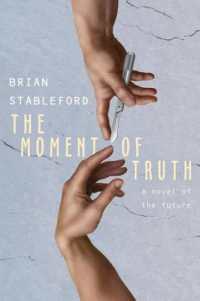- ホーム
- > 洋書
- > 英文書
- > Performing Arts
Full Description
Inclusive Dance is an ethnography of disability arts, and historiographic overview of the 1980s when many new disability arts groups came to fruition. Touchdown Dance was the research 'ambition' of dancer Steve Paxton and theatre maker and psychotherapist Anne Kilcoyne, involving visually impaired and sighted adults in Contact Improvisation - a dyadic movement form requiring physical contact. Katy Dymoke took over Touchdown Dance in 1994 and refers here to archives, accounts and personal experience to share the learning that has been shared over the years to today.
Touch and movement are vital for accessibility and inclusion and modality specific approaches were devised to ensure a democratic process towards the inclusion of visually impaired people in a pro-touch activity. The continuum of movement based methods fills the gaps in polarities of visual and nonvisual and a two-way membrane interlinks all the participants in a body focused learning experience. The mutable membrane becomes a heuristic device for the relational realm, a locus for debate, for change. Touch deprivation, exclusion and inequality are the consequence of an inaccessible visually dominant society.
Three point of view chapters - from two visually impaired and one sighted company dancer - further describe the performance work, revealing how lives are changed and why sociocultural inclusion is imperative.
Contents
List of Figures
Abbreviations
Preface
Acknowledgements
Introduction
- An ethno-historical overview of the origins of Touchdown Dance: A radical initiative in a radical climate
- Part 1. Taking a stand for inclusivity in an exclusive society
- Part 2. The body as the locus of liberation
- Part 3. Bringing CI and Touchdown Dance to Denmark
1. Returning to the Origins: The Journey Taken by the Founders
- Part 1. A chance encounter - Where it all started
- The first years of Touchdown Dance 1986-88 - Finding a common way of seeing using CI
- Bringing visually impaired and sighted people together through CI
- The first encounter - A mini revolution
- Part 2. Touchdown Dance (1988-94), Breaking new ground, new discourses, new science, new praxis: Re-inhabiting the body brought into question the perception of the visible and invisible
- Part 3. Finding my place
2. Methodology: Undertaking Research That Is Practice-Led
- Contact Improvisation - Sowing the seeds of self-determination through touch and movement
- CI - A practice-led approach to learning
- Part 1. CI - The inter-relationship of pedagogy and practice-led research - The advent of an integrated and inclusive approach
- Part 2. The foundational principles in practice
- Vignette 1: An integrated exchange and inter-corporeal event - The three reciprocal membranes
- Vignette 2: Touch - On the gap between physical and verbal language - The motile membrane between states of consciousness
- Part 3. The role of discursive, ethnographic methods
3. Touch Communication: The Reciprocal Membrane of Inclusion
- Part 1. Touching the skin is touching the membrane of the inner body
- Part 2. In search of a natural attitude towards touch
4. The Pedagogic Process in Practice
- Part 1. Introduction
- Working with movement - A path towards change
- CI - A sphere for cultural motility and mutability
- The transitional state - New ways of seeing, moving and being
- Part 2. The different modality-specific methods
- Modality 1: The lower six inches
- Modality 2: Rolling
- Modality 3: Back-to-back sitting
- Modality 4: Stand on 'all fours' - The low 'bridge' or 'table'
- Modality 5: Lifts - Pathways into space and back to the floor
5. Workshops: Our Partnerships and Projects Since 1994
- Children
- Youth work
- How would you rate your movement skills before and after the workshop?
- Adults
6. Performance and Creative Process
- Sixth Sense - Second Sight: Practice-based research - In performance
- Productions post 1994
- I-radiate - 1999-2000
- SENSE-8 2000-01
- TACT 2002-03
- CLOSER. Created 2005-08 reworked as APPARENTLY NORMAL 2010-12
- Follow the frame
- 343 m/s - The speed of sound
- 343 m/s Lisbon
7. Final Words
- The paradigm shift - Towards the individual and collective - Embracing the membrane of inclusion
- The research accomplishments and the return of non-touch
- Capturing the experience - The multiple membranes
8. Three Touchdown Dance Artists' Points of View
- Introduction
- Holly Thomas - Dancer and facilitator
- Sharing practice
- Performance work
- Robert Anderson - Dancer and facilitator
- Jamus Wood - Dancer and facilitator
Afterword - Steve Paxton
Appendix 1. The Small Dance 329
Appendix 2. The 'Hatching Chick' - And the 'birth' of the Membrane Concept
Timeline
Notes
Bibliography


![Quattro codici : civile e di procedura civile, penale e di procedura penale e leggi complementari : [aggiornato con il D.L.vo 12/8/2016 n. 176 (Modifiche al Testo unico della finanza)] (I codici vigenti)](../images/goods/../parts/goods-list/no-phooto.jpg)




